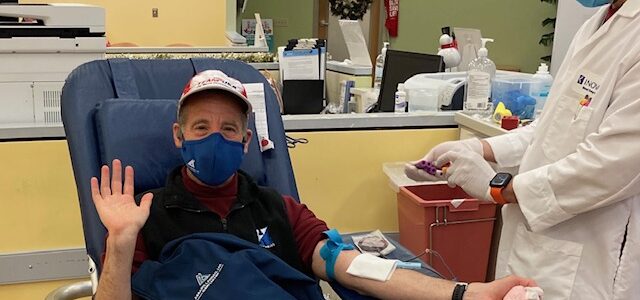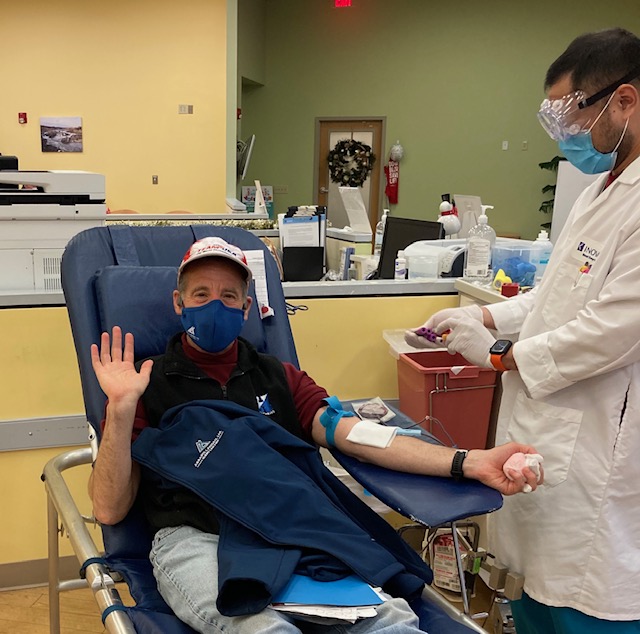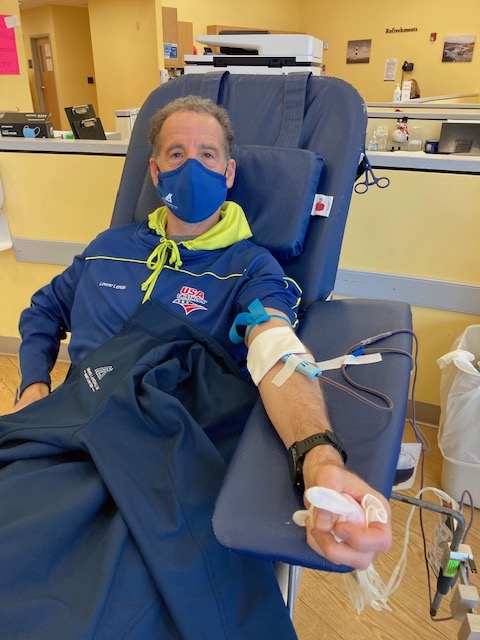
Athletes & Blood Donation: What’s the Story?
 As one who regularly donates blood, Doug Landau was wondering what the statistics were and whether there was an impact on athletes who give blood. According to the Red Cross, every 2 seconds there’s an American in need of blood, requiring roughly 41,000 donations per day. In the United States of America, more than 100 million people are eligible to donate, although only about 9 million do so every year. The need for blood donation is especially important for our fellow Americans who are battling disease, illness and accidental injury. Cancer, which affects some 14 million people, requires frequent blood transfusions. Hospitals also need a continuous supply of fresh blood for surgical patients, laboring mothers, and traumatic injury cases like the ones we frequently work with at ABRAMS LANDAU, Ltd. During the COVID Epidemic, lawyer Doug Landau was on track to donate when he became eligible, about every 8 weeks after each donation.
As one who regularly donates blood, Doug Landau was wondering what the statistics were and whether there was an impact on athletes who give blood. According to the Red Cross, every 2 seconds there’s an American in need of blood, requiring roughly 41,000 donations per day. In the United States of America, more than 100 million people are eligible to donate, although only about 9 million do so every year. The need for blood donation is especially important for our fellow Americans who are battling disease, illness and accidental injury. Cancer, which affects some 14 million people, requires frequent blood transfusions. Hospitals also need a continuous supply of fresh blood for surgical patients, laboring mothers, and traumatic injury cases like the ones we frequently work with at ABRAMS LANDAU, Ltd. During the COVID Epidemic, lawyer Doug Landau was on track to donate when he became eligible, about every 8 weeks after each donation.
While a necessary and benevolent act, which some like lawyer Landau consider part of their “Civic Duty,” recreational and competitive athletes should be aware that donating blood is not without physical consequences. These can include a temporary reduction in endurance performance, and in some cases, iron-deficiency. Whenever Doug Landau goes to donate blood at a Bloodmobile, an INOVA permanent facility or other donation center, they check his temperature, go over health questions and test his hematocrit to make sure that he is healthy enough to give blood safely. Landau gives “whole blood,” which is usually a pint of blood, during each session. Your body contains approximately10 pints of blood, one of which you give away during a “whole blood” donation. One pint of blood is 450-500 milliliters, or “one unit,” which you may have heard on television shows like “E.R.,” “Scrubs,” “House,” and “Grays Anatomy.” Donating one-tenth of our blood may seem like a lot until you consider that a car crash victim could need up to 100 pints of blood just to survive!

When giving blood, most donors opt for the more common donation type called “whole blood” donation. Others choose a partial donation in which only parts of what runs through our veins is extracted. The component parts are: plasma, red blood cells (“RBCs”), and platelets. During a whole blood donation, blood is taken from the arm, and then separated later into its usable parts. These parts can benefit up to three other people! A partial donation is performed nearly the same way except that the donated parts, platelets for example, are machine-separated from the blood, then the remaining parts are returned back to the donor’s arm.
When he worked at Columbia Presbyterian Neurological Institute in New York City, Doug Landau actually spun whole blood to separate out the component parts with a refrigerated centrifuge. This spinning machine would separate out the heavy, iron rich RBCs, the White Blood Cells (“WBCs”) and the straw colored plasma on top. Regardless of donation type, every part of your blood can be (and is, according to the Red Cross) used to help someone in need. RBCs have a short shelf-life of only 42 days, which underscores the need for regular donation, proper handing and refrigeration. Platelets, which are the key to blood clotting, are also separated and saved. Various conditions can drop a patient’s platelet counts dangerously low, in which case bleeding can become an issue; platelet transfusions may be life-saving for them. Protein-rich plasma is the fluid that carries and suspends all the other components of the blood. Plasma has many uses, and can be given to patients with various ailments from autoimmune processes like Guillain Barré syndrome or Myasthenia Gravis; or more recently, for patients with severe COVID-19, or related illness.

What about your own body? What happens to the donor after they eat their cookies, drink the juice and leave the donation center? After donation, the donor’s body goes to work regenerating the lost blood. The body senses a reduced volume, less oxygen is being carried by RBCs and your heart has less to pump. Your plasma recovers the quickest, in about 24 hours. The Red Cross recommends no strenuous exercise during this period, until your “fluid,” or plasma normalizes. Platelets restore next, usually within a 72-hour period. The oxygen carriers or RBCs are the slowest to regenerate, taking 4-6 weeks to fully rebound. This is not great news for competitive athletes who want to donate, but who have a key “A Race” within the fortnight. The lag in RBC recovery is an obvious indicator that an athlete’s endurance performance will suffer until pre-donation levels are restored. According to the National Academy of Sports Medicine (“NASM”) post
Significant drops in performance measures from 24 hours to two days post-donation in active young adults have been reported, including VO2 max, work rate, and time to exhaustion. A 9% decrease in VO2 max, and a 13% drop in maximal work rate following a 500-ml whole blood donation has been reported in an NIH peer-reviewed study. Unsurprisingly, researchers found significant decreases in subjects’ hemoglobin (Hb), too. Haemoglobin is the critical protein found in red blood cells (RBCs), whose function is to transfer oxygen from the lungs to the body’s tissues. A drop in Hb compromises both the amount of oxygen that can be delivered to working cells, as well as oxygen’s ability to dissociate once it arrives, called diffusing capacity (DO2). Both factors contribute to an overall decrease in VO2 max. Interestingly, one study noted a direct correlation between Hb and VO2 max such that if one is reduced by 5%, a roughly 5% decrease in the other can be expected, and vice versa.
If you’re an athlete that wants to donate blood, it’s completely feasible to do so, but probably best delayed until after your critical training or competition periods. Consider donating during the off-season when training is lighter and performance isn’t an imminent concern. Listen to the Red Cross’s advice; give yourself 24 hours rest afterward to allow your plasma levels to restore, and hydrate and fuel well before and after your donation. Donating blood costs nothing and accomplishes so much. How many athletes can say that they have done something that saves lives?
